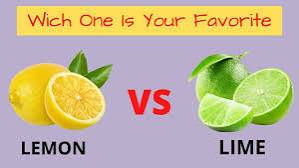The Difference Between a Lime and a Lemon: A Citrus Comparison
Limes and lemons are both popular citrus fruits, often used in culinary dishes, beverages, and as natural flavor enhancers. While they share some similarities, these two fruits differ in several key aspects, including their appearance, flavor, nutritional content, and uses. Understanding these differences can help in choosing the right fruit for a recipe or understanding their unique benefits.
Appearance and Color
The most noticeable difference between limes and lemons is their color and shape. Limes are typically smaller, measuring about 2 to 3 inches in diameter, and are green when ripe, though some varieties turn yellow when fully mature. In contrast, lemons are larger and usually have a bright yellow, textured rind. The shape of a lemon is more oblong, while limes are rounder or oval in shape.
Despite their differences in color, both fruits have a similar, smooth, waxy outer rind that protects the juicy flesh inside. However, the texture and thickness of the peel vary: limes tend to have a thinner, more delicate skin, while lemons have a thicker rind.
Flavor Profile
The flavor of each fruit is another distinguishing factor. Lemons have a tart, acidic, and slightly sweet flavor that makes them a versatile ingredient in both savory and sweet dishes. Their acidity also gives them the ability to balance out rich, fatty, or sweet foods, making them a common addition to everything from marinades to desserts.
Limes, on the other hand, tend to have a sharper, more intense tartness. They possess a distinct, slightly bitter undertone that can vary depending on the variety of lime. Persian limes, the most common variety found in supermarkets, have a mild flavor, while Key limes (often used in pies and cocktails) are more fragrant and pungent. Limes are often favored in Mexican, Thai, and Indian cuisines due to their bold flavor profile.
Nutritional Differences
Both limes and lemons are low in calories and high in vitamin C, making them excellent choices for boosting immune health. A medium-sized lemon contains approximately 31 calories, while a medium lime contains around 20 calories. Despite their similar calorie content, lemons have slightly higher amounts of vitamin C. A single lemon typically contains about 30 milligrams of vitamin C, while a lime contains about 20 milligrams. However, both fruits provide a good source of antioxidants, fiber, and other essential nutrients.
Culinary Uses
In the kitchen, both limes and lemons are incredibly versatile. Lemons are widely used in baking, desserts (like lemon meringue pie or lemon bars), salad dressings, and beverages such as lemonade or cocktails like the classic gin and tonic. The zest of a lemon is also prized for its aromatic oil and flavor, often used to enhance the flavor of dishes.
Limes, meanwhile, are a key ingredient in many savory dishes, particularly in Latin American, Middle Eastern, and Southeast Asian cuisines. They are used to flavor seafood, salads, tacos, and curries. Limes are also essential in cocktails such as margaritas and mojitos, and their zest can be used similarly to lemon zest to add a citrusy punch.
Conclusion
While both limes and lemons belong to the same citrus family and share many similar uses, their distinct flavor profiles, appearances, and subtle nutritional differences set them apart. Limes are often more tart and intense, while lemons offer a milder balance of sourness and sweetness. Understanding these differences can elevate your culinary creations and help you use the right fruit for the right dish.


